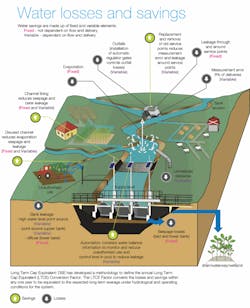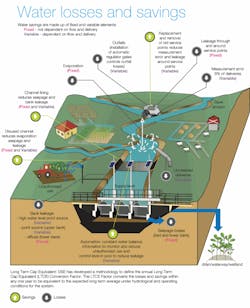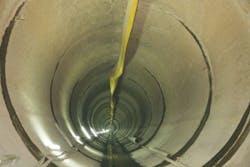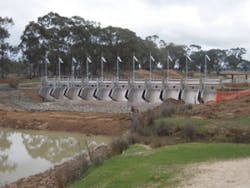Stemming leakages Down Under
A multi-billion dollar project led by the Australian government aims to reduce water losses, seepages and leakages which have severely impacted on the country’s water flow over the years. A sophisticated metering system has been installed to help cut future losses and maximise irrigation water to local farmers.
The worst drought on record in one of Australia’s most valued food producing regions has highlighted the need to modernise the country’s most extensive irrigation system.
A decade of low rainfall resulting in reduced water allocation to farmers, poor environmental flows and urban water restrictions has forced the Victorian and Australian Governments to invest $AUD 2 billion on upgrading the system over eight years.
The 80-year-old, 6020km open channel system in northern Victoria loses on average between 700 and 800 gigalitres of water each year in distribution losses, through evaporation, seepage, leakage and other inefficiencies.
Using channel automation and metering, coupled with channel lining and remediation works as well as an overhaul of the on-farm irrigation layout, the project aims to secure the future of this fertile region by halving the system’s water losses and moving from 70% efficiency to 85% in most areas.
Once upgraded, the system will save 425 gigalitres (GL) of water each year that will be shared between the region’s farmers, the Murray Darling Basin’s rivers and tributaries, and Melbourne water users. It aims to provide a better service for irrigators, allowing them to increase their efficiency and productivity and help keep costs down in the long-term.
Known as Victoria’s food bowl, the region’s 12,600 farms harvest a diverse range of food products including dairy, deciduous fruits, grains, olives, beef and oilseeds. The region contributes about $AUD1.5 billion to the economy and earns significant export revenue annually.
The Northern Victoria Irrigation Renewal Project (NVIRP) is the largest irrigation upgrade in the nation’s history and is a forerunner in this specialised field attracting the attention of neighbouring and off-shore irrigation districts.
NVIRP CEO Murray Smith says the project’s focus was on identifying where the losses were coming from and finding ways to reduce them.
"We know that most of the losses come from evaporation, leakage and seepage in banks, meter inaccuracy and leakage around ageing infrastructure," says Smith.
"The project will deal with each of these inefficiencies in a strategic manner. Evaporation will be managed by rationalising more than half of the present channel system; leakage and seepage will be addressed with remediation works and some channel lining; old, inaccurate meters will be replaced with a sophisticated metering system that will measure water flow precisely and eliminate losses around the old irrigation structures.
"Furthermore the service will be vastly improved by installing a fully automated system. The project is about to enter its second year of works and despite the continuing drought and poor inflows, savings have been made. This year, our water savings are being audited and the amount will be known soon."
The project is best described as having three major components.
First, a network of major backbone channels have been identified, which will be modernised. The backbone was identified by assessing land use suitability for irrigation as well as how well it will be used.
"The aim is to consolidate the existing system which was built during a time of high rainfall and without much planning for the future," adds Smith. "Our target is to reduce the system from 6300km to around 2500km of channel. These backbone channels will then be automated, producing a highly efficient service for irrigators delivering near on-demand supply."
The CEO goes on to say: "Until now, farmers have had to open and close shutters and gates themselves and order water up to four days in advance. In some instances, this means a lot of time is taken up driving around the farm lifting gates and closing gates so the automatic option given to farmers is an added benefit."
As part of the backbone modernisation, the sophisticated Total Channel Control (TCC®) product developed in Victoria by Rubicon Systems will be used.
This provides a central control for regulators and meters. Farmers use an interface to order water: when orders are placed, the system can immediately assess how this will impact on the overall system. A highly reliable and very fast wireless network enables the orders to then be carried out immediately. Once orders are delivered, the system produces accurate reports to account for water usage.
Using the online system, farmers can view past and present orders to ensure they were placed and delivered. The back end of the TCC can check the orders, adjust them if necessary, coordinate a new order with orders from other clients, calculate and schedule gate controls, and interface with the Relational Database Management System.
One of its key features is the ability to account for all water usage and therefore identify any leaks or unauthorised use. Any discrepancies can then be investigated and remediation works will be carried out. Some backbone channels will also be lined to minimise seepage and bank leakage.
Once the backbone has been modernised, all farms will be connected directly to the network of modern backbone channels. NVIRP modernisation coordinators will work with farmers to identify the best way to achieve this and find ways to decommission redundant infrastructure on farms such as meters, regulator gates and sections of old, leaky spur channel.
Compensation payments from NVIRP will be made to irrigators to encourage them to take part in the program.
Smith says: "By removing a branch or spur channel, we remove the opportunity for evaporation, seepage and leakage entirely. This land, when freed, up can be returned to the farmer for productive use."
He says decommissioning channels was the most long-term, cost effective and efficient way to manage evaporation. In the Goulburn Murray Irrigation District, the average mean temperature during the summer months is about 30 degrees Celsius, making evaporation a well considered problem. Smith said other regions were experimenting with shade cloth over channels but this had so far been ruled out for NVIRP due to cost and ongoing maintenance.
A new metering system is the third modernisation strategy. The new meters will precisely measure water delivery to farms. They will replace old Dethridge wheels that are inaccurate, attract water losses around the old structures and do not meet the Australian national metering standards. This will further help inform the water balance and ongoing investment decisions.
Farmers will have the option of an automated or manual FlumeGate™, also developed by Rubicon Systems, or a MagFlow meter. For many irrigators, a faster flow rate on to their crop or pasture provided by the new system will mean less water will be needed.
Some farmers have already taken part in the process, reconfiguring their farm system and replacing their old Dethridge wheels and are raving about the results.
Jade and Trevor Clymo are dairy farmers who have been in the area for about 30 years. With the help of a farm irrigation designer the program decommissioned 2.8 km of spur channel, two regulator gates and seven Dethridge wheels. Their system was restructured to save water and to create a better service level for their dairy enterprise.
"This farm restructure had us really thinking outside the box and it is a once in a lifetime opportunity to make the changes we have never been able to afford," says Trevor Clymo.
And the results speak for themselves. Water savings achieved by this restructure at the Clymo’s property were almost 200 ML per annum.
The project has placed heavy considerations on the environmental consequences of modernising the old leaky system. It was found that some key wetlands were fed incidental water through bank leakage and seepage.
Environmental watering plans have been developed for a number of high value wetlands in the region to ensure these valued areas continue to receive water once the system has been modernised.
The concept of the renewal project was originally developed by a group of community members known as the Goulburn Valley Food Bowl Group, made up of farmers and businessmen who saw the potential of the region as a major food producing area under threat.
The group realised that the ageing irrigation system, combined with the driest decade on record, could lead to the region’s demise. They presented to the Victorian Government the concept of investing to upgrade the existing system and sharing the savings between irrigators, the environment and Victoria’s capital city Melbourne’s suburban water-users.
The Victorian Government, Melbourne Water and Goulburn-Murray Water have funded stage one of the project, costing $AUD 1 billion. The Australian Government has agreed in principle to contribute up to $AUD 1 billion for the second stage however, this is subject to due diligence. A business case for stage two will be presented to the Australian Government in coming months.
"The drought has exposed a need to shift our thinking about water usage for households and irrigators alike remembering that every drop counts," adds Smith. "This is certainly the most exciting investment in irrigation in this country and has triggered a myriad of financial benefits for the region suffering from a decade-long drought.
"The irrigation modernisation project is securing a future for the next generation of farmers in the foodbowl of Victoria."
Author’s note:The article was prepared on behalf of the NVIRP by Merrill Boyd, executive manager of communications. More information on the project can be found at: www.nvirp.com.au
More Water & WasteWater International Current Issue Articles
More Water & WasteWater International Archives Issue Articles



